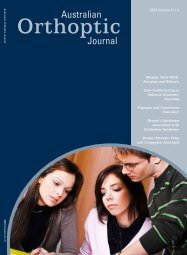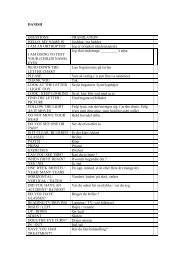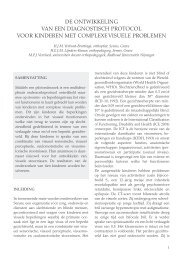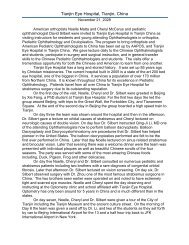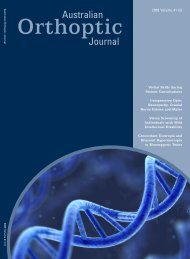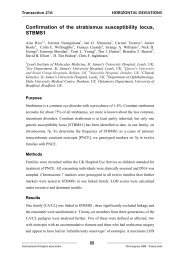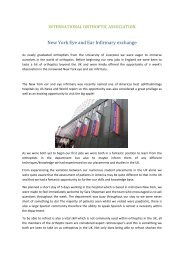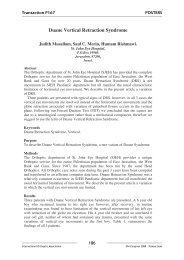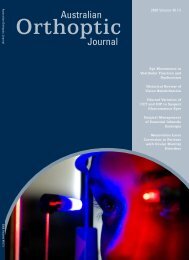Transactions from the Xth International Orthoptics Congress 2004
Transactions from the Xth International Orthoptics Congress 2004
Transactions from the Xth International Orthoptics Congress 2004
Create successful ePaper yourself
Turn your PDF publications into a flip-book with our unique Google optimized e-Paper software.
Table 3. Mean fusional convergence amplitude at baseline and varying levels of SE.<br />
SE Mean fusional conv. amp. SE (cont.) Mean fusional conv. amp. (cont.)<br />
Baseline (0 o ) 41.42 (+/- 24.52) 6 o 25.71 (+/- 18.75)<br />
2 o 33.38 (+/- 19.53) 8 o 21.00 (+/- 14.57)<br />
4 o 28.38 (+/- 15.63) 10 o 13.81 (+/- 10.65)<br />
<br />
Table 4. Pairwise comparison between <strong>the</strong> baseline mean amplitude of fusional convergence and means at each<br />
level of SE.<br />
Orthophoria (O) Excyclotropia (E) Mean difference (O-E) Significance<br />
0 o 2 o 8.04 0.806<br />
4 o 13.04 0.063<br />
6 o 15.71 0.056<br />
8 o 20.42 0.002<br />
10 o 27.61 0.000<br />
All subjects achieved stereoacuity of 90” without any SE, as was <strong>the</strong> case at 2 o of SE.<br />
At 4 o of SE, <strong>the</strong> first effects of <strong>the</strong> torsional disparity on stereoacuity became evident with 3<br />
subjects (14.3%) no longer being able to appreciate <strong>the</strong> random dot slide images representing<br />
90”. Of <strong>the</strong>se 3 subjects, 2 were still able to appreciate stereoacuity of 180” and <strong>the</strong> remaining<br />
subject was only able to appreciate gross stereopsis representing 360” or greater.<br />
At 6 o of SE, 9 subjects (42.9%) were able to appreciate stereoacuity of 90”. Of <strong>the</strong><br />
remaining 12 subjects; 3 achieved stereoacuity of 180”; 3 identified <strong>the</strong> images representing<br />
360”; 1 had stereoacuity of 720”; and 5 (23.8%) were not able to achieve any stereopsis.<br />
At 8 o of SE, 4 subjects (19%) were still able to identify images representing 90”. Of<br />
<strong>the</strong> remaining subjects, 1 (4.8%) had stereoacuity of 180” and 16 (76.2%) were not able to<br />
achieve any stereopsis. At 10 o of SE, no stereopsis was achieved by any but 1 subject, who<br />
unexpectedly maintained stereoacuity of 90”. This result was obviously an outlier.<br />
Discussion<br />
Two papers published in <strong>the</strong> last decade are particularly important as far as <strong>the</strong> present study<br />
is concerned. The first is by Sharma et al (1999), who reported that baseline horizontal<br />
fusional vergences decreased once levels of simulated torsion reached approximately 4 o .(9)<br />
Their findings were indicative of a gradual decrease in horizontal fusional vergences across<br />
<strong>the</strong> range of torsional fusion, <strong>the</strong> mean torsional fusion amplitudes being about 13 o . The<br />
present study supports <strong>the</strong> findings of Sharma et al (1999) and expanded on <strong>the</strong>m to provide a<br />
more definitive explanation of <strong>the</strong> effect of SE on horizontal fusion.<br />
The second study is by Yagasaki et al (1994), who explored stereoacuity in <strong>the</strong><br />
background of torsional disparity and found that a random dot stereoscopic image of 125”<br />
could not be appreciated beyond 4 o of SE.(10) However, a coarse disparity of 805” was able<br />
to be appreciated with up to 9 o of SE. The present study bridges <strong>the</strong> knowledge gap between<br />
such fine and coarse stereoacuity levels.<br />
The findings of <strong>the</strong> present study can be summarised as follows. With respect to<br />
fusional divergence, <strong>the</strong> baseline measurements became statistically significantly affected at<br />
6 o of SE, though even at 4 o of SE <strong>the</strong> significance level was 0.087. Similarly with fusional<br />
convergence; <strong>the</strong> baseline measurements came statistically significantly affected at 8 o of SE,<br />
though at 6 o and even 4 o of SE <strong>the</strong> significance levels were 0.056 and 0.063, respectively,<br />
indeed close to <strong>the</strong> set alpha of 0.05. Certainly, <strong>the</strong>se mean measurements relative to <strong>the</strong><br />
baseline were conspicuous <strong>from</strong> a clinical perspective.<br />
With respect to stereopsis, <strong>the</strong>re was no deterioration of stereoacuity with 2 o of SE.<br />
Nor did 4 o of SE have a significant effect - 18 subjects (86%) appreciated stereoacuity of 90”,<br />
and 20 subjects (95%) appreciated stereoacuity of 180”. Beyond 4 o of SE, <strong>the</strong>re was a marked<br />
decrease in <strong>the</strong> number of subjects able to appreciate <strong>the</strong> finest (90”) level of stereoacuity. At<br />
3



